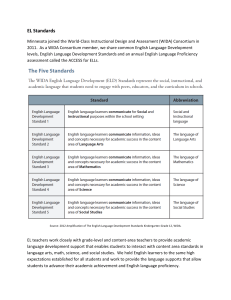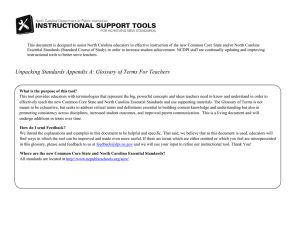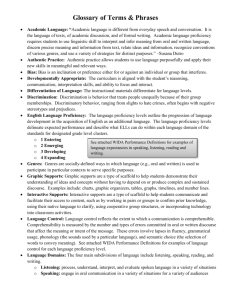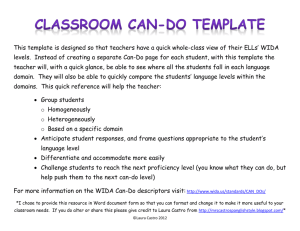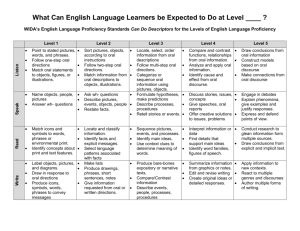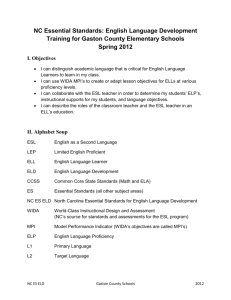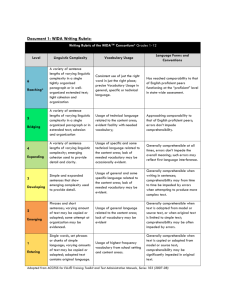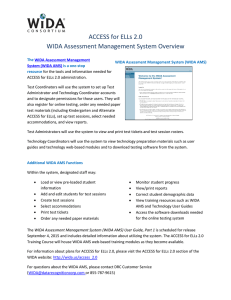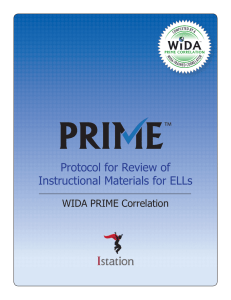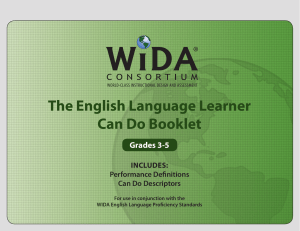Document 10710797
advertisement
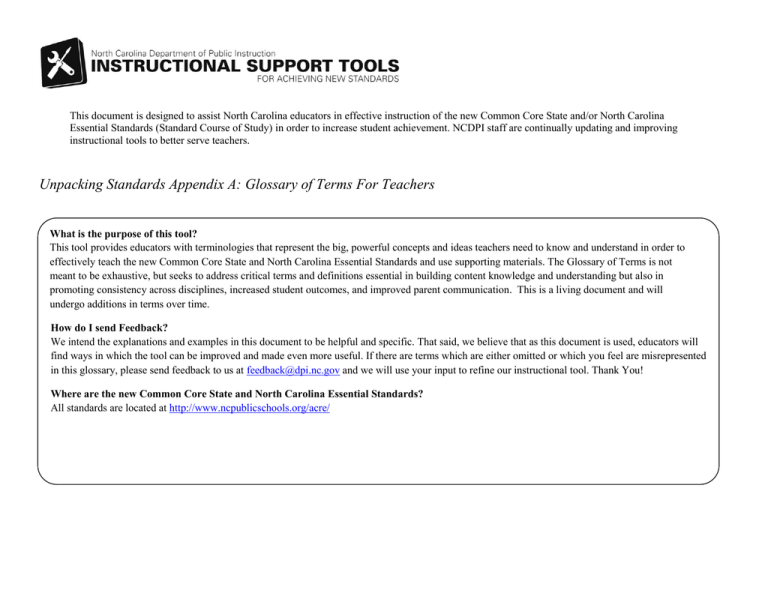
This document is designed to assist North Carolina educators in effective instruction of the new Common Core State and/or North Carolina Essential Standards (Standard Course of Study) in order to increase student achievement. NCDPI staff are continually updating and improving instructional tools to better serve teachers. Unpacking Standards Appendix A: Glossary of Terms For Teachers What is the purpose of this tool? This tool provides educators with terminologies that represent the big, powerful concepts and ideas teachers need to know and understand in order to effectively teach the new Common Core State and North Carolina Essential Standards and use supporting materials. The Glossary of Terms is not meant to be exhaustive, but seeks to address critical terms and definitions essential in building content knowledge and understanding but also in promoting consistency across disciplines, increased student outcomes, and improved parent communication. This is a living document and will undergo additions in terms over time. How do I send Feedback? We intend the explanations and examples in this document to be helpful and specific. That said, we believe that as this document is used, educators will find ways in which the tool can be improved and made even more useful. If there are terms which are either omitted or which you feel are misrepresented in this glossary, please send feedback to us at feedback@dpi.nc.gov and we will use your input to refine our instructional tool. Thank You! Where are the new Common Core State and North Carolina Essential Standards? All standards are located at http://www.ncpublicschools.org/acre/ The World-Class Instructional Design and Assessment (WIDA) Consortium has published a Glossary of Terms and Expressions associated with WIDA’s English Language Development Standards. [As of this date the glossary is in draft form. Final version is expected by August 2012.} The English Language Development Standards, Kindergarten through Grade 12 Glossary of Terms and Expressions academic content standards: the skills and knowledge descriptive of student expectations in the core content areas for each grade academic language: the language required to succeed in school that includes deep understandings of content and communication of that language in the classroom environment. These understandings revolve around specific criteria related to discourse, sentence, and word/phrase levels of language amplified matrix: the format for representing the WIDA English language development standards that includes the additional elements of the three performance criteria used in the Defining Features of Academic Language (Linguistic Complexity, Language Forms and Conventions, Vocabulary Usage) cognitive functions: the mental processes involved in learning Common Core State Standards: the skills and knowledge descriptive of student expectations in English language arts, mathematics, K-12, and literacy in history/social studies, science, and technical subjects, 6-12, adopted by the vast majority of states in the U.S. complementary strand: the use of the standards matrix to illustrate how critical areas of schooling outside the English language development standards, such as technology and visual arts, are presented through the five levels of language proficiency content stem: the element of Model Performance Indicators, derived from state and national content standards, that provides a standards-reference example for contextualizing language development Context for Language Use: situating the representation of the English language development standards within a socio-cultural setting that considers the register, genre/text type, topic, and task discourse: the form in which written or oral language is communicated; the text type or genre associated with extended communication Discourse Complexity: the organization, cohesion and relationship between ideas expressed in the variety and kinds of sentences that make up different genres and text types in oral or written language © September 2011, Board of Regents of the University of Wisconsin System on behalf of the WIDA Consortium DRAFT The English Language Development Standards, Kindergarten through Grade 12 English language learners (ELLs): linguistically and culturally diverse students who have been identified (by the W-APT or MODEL, local placement criteria, and perhaps other measures) as having levels of English language proficiency that preclude them from accessing, processing, and acquiring unmodified grade level content in English features of academic language: the performance criteria associated with discourse, sentence, and word/phrase levels of oral and written communication; namely, linguistic complexity, language forms and conventions, and vocabulary usage genre: tasks and text types of and within different disciplines instructional supports: available sensory, graphic, and interactive resources to assist students in constructing meaning from language and content language development standards: descriptions of the language expectations for students that are marked by specified progressions or levels across the language development continuum language domains: the modalities of language; listening, speaking, reading, and writing language functions: linguistic processes required in conveying a message; the first of the three elements in Model Performance Indicators that indicates how ELLs are to process or use language to demonstrate their English language proficiency language proficiency: a person's competence in processing (through listening and reading) and using (through speaking and writing) language Language Forms and Conventions: the grammatical structures, patterns, syntax, and mechanics associated with the sentence level meaning language development standards: the language expectations for each grade level that scaffold across five levels of language proficiency levels of language proficiency: the arbitrary division of the second language acquisition continuum into stages of language development; the WIDA ELD standards have 6 levels of language proficiency- Entering, Emerging, Developing, Expanding, Bridging, and Reaching model performance indicator (MPI): a single cell within the standards matrix that is descriptive of a specific level of English language development for a language domain © September 2011, Board of Regents of the University of Wisconsin System on behalf of the WIDA Consortium DRAFT The English Language Development Standards, Kindergarten through Grade 12 register: features of language that vary according to the context and purpose of the communication (e.g., the speech used when students talk to their peers versus their principal) social language: the everyday and instructional registers used in interactions outside and inside school standards matrix: the basic format in which the English language development standards are represented with language proficiency levels expressed along the horizontal axis and the language domains of listening, speaking, reading, and writing expressed along the vertical axis strands of model performance indicators (MPIs): the five sequential or scaffolded levels of English language development for a given topic and language domain within the standards matrix text types: the genres associated with each English language development standard Topical Vocabulary: grade-level words and expressions that typify the example topic within the standards matrix Vocabulary Usage: the specificity of words or phrases for a given context © September 2011, Board of Regents of the University of Wisconsin System on behalf of the WIDA Consortium DRAFT
